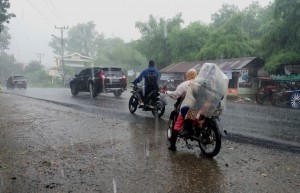BMKG Warns of Heavy Rain at the End of January
 The Meteorology, Climatology, and Geophysics Agency (BMKG) on 16 January 2019 issued a warning and called on the public to remain vigilant and cautious ahead of the peak of rainy season this year.
The Meteorology, Climatology, and Geophysics Agency (BMKG) on 16 January 2019 issued a warning and called on the public to remain vigilant and cautious ahead of the peak of rainy season this year.
Particularly be vigilant of the impacts of high rainfall that can lead to hydro meteorological disasters including floods, landslides, flash floods, strong wind, which are predicted to intensify by the end of January this year, Deputy Head of the BMKG for Meteorology Mulyono R. Prabowo said in a press release on Tuesday (22/1).
Based on analysis on atmospheric dynamics (22/1), wet air masses from Indian Ocean are still entering Java, Kalimantan, Bali, West Nusa Tenggara and East Nusa Tenggara. At the same time, strong cold monsoon from Asia and warmer sea ??surface temperature will increase evaporation rate and lead to the growth of rain clouds.
The BMKG also detected a convergence pattern of wind circulation that extends from soutern part of Sumatra, Java Sea, East Java, Bali, to West Nusa Tenggara and East Nusa Tenggara in the past few days.
In addition, the Jakarta Tropical Cyclone Warning Center (TCWC) informed that there are three potential tropical cyclones near the Indonesian territory.
One of them is located in Timor Sea (94S) and is predicted to become a tropical cyclone in the next three days, resulting in a potential for extreme weather including strong wind of more than 25 knot in several parts of Indonesia such as Riau, Riau Islands, Jambi, South Sumatra, Bangka Belitung, Banten, Special Capital Region of Jakarta (DKI Jakarta), Central Java, East Java, Bali, West Nusa Tenggara, East Nusa Tenggara, Southeast Sulawesi, and South Sulawesi, Mulyono explained.
He went on to say that some regions that are prone to heavy rains in 23-26 January 2019 are: 1. Aceh; 2. Lampung; 3. Banten; 4. DKI Jakarta; 5. West Java; 6. Central Java; 7. Special Region of Yogyakarta; 8. East Java; 9. Bali; 10. West Nusa Tenggara; 11. East Nusa Tenggara; 12. North Kalimantan; 13. South Sulawesi; 14. Southeast Sulawesi; 15 West Papua; and 16. Papua.
In addition, regions that are prone to heavy rains in 27-30 January 2019 are, among others: 1. South Sumatra; 2. Bangka Belitung; 3. Bengkulu; 4. Lampung; 5. Banten; 6. DKI Jakarta; 7. West Java; 8. Central Java; 9. Special Region of Yogyakarta; 10. East Java; 11. Bali; 12. West Nusa Tenggara; 13. East Nusa Tenggara; 14. East Kalimantan; 15. North Kalimantan; 16. South Sulawesi; 17. Southeast Sulawesi; 18. Maluku; 19. West Papua; and 20. Papua.
Mulyono further said that fishermen and residents living at coastal areas also need to be aware of 2.5 to 4.0 meter high ocean waves that are likely to occur in western waters of Simeulue Island to Mentawai Islands, Enggano Island waters to western part of Lampung, southern part of Sunda Strait, southern waters of Banten to Central Java, West Indian Ocean from Sumatra to Central Java, Northern waters of Anambas Islands and Natuna Sea, central part of Java Sea, Bali Sea, southern waters of Baubau-Wakatobi Islands, southern part of Banda Sea, waters of Sermata Islands-Babar Islands, and western part of Arafuru Sea.
In addition, 4.0 to 6.0 meter high ocean waves are likely to occur in South China Sea and North Natuna Sea, northen waters of Natuna Islands, eastern part of Java Sea to Sumbawa Sea, southern part of Makassar Strait, southern waters of East Java to Rote Island, Bali Strait, Lombok-southern part of Alas Strait, South Indian Ocean from East Java to East Nusa Tenggara, northen waters of Flores, waters of Sabalana Islands-Selayar Islands, Flores Sea, Sawu Sea, and Timor Sea.
We urged the public to remain vigilant and cautious of the impacts of high rainfall and strong wind that are predicted to occur at the end of January 2019, Mulyono said, adding that the impacts include floods, landslides, flash floods, inundations, strong wind, fallen trees, and slippery roads. (EN/Humas BMKG/ES)
Translated by : Rany Anjany Subachrum
Edited by : Muhardi








